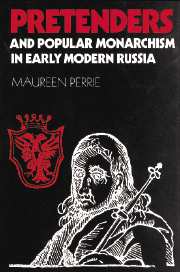Book contents
- Frontmatter
- Contents
- List of illustrations
- Preface
- Note on transliteration, names and dates
- Chronology of events
- Glossary of Russian terms
- List of abbreviations
- Introduction
- Prologue: Tsarevich Dimitry and Boris Godunov
- Part 1 The First False Dimitry
- Part 2 Rebels in the name of Tsar Dimitry
- Part 3 The final stages of the Troubles
- 6 The Second False Dimitry: from Starodub to Tushino
- 7 The Second False Dimitry: Tushino and Kaluga
- 8 Tsarevich Ivan Dimitrievich
- Epilogue: After the Troubles: pretence in the later seventeenth century
- Conclusion
- Bibliography
- Index
6 - The Second False Dimitry: from Starodub to Tushino
Published online by Cambridge University Press: 03 December 2009
- Frontmatter
- Contents
- List of illustrations
- Preface
- Note on transliteration, names and dates
- Chronology of events
- Glossary of Russian terms
- List of abbreviations
- Introduction
- Prologue: Tsarevich Dimitry and Boris Godunov
- Part 1 The First False Dimitry
- Part 2 Rebels in the name of Tsar Dimitry
- Part 3 The final stages of the Troubles
- 6 The Second False Dimitry: from Starodub to Tushino
- 7 The Second False Dimitry: Tushino and Kaluga
- 8 Tsarevich Ivan Dimitrievich
- Epilogue: After the Troubles: pretence in the later seventeenth century
- Conclusion
- Bibliography
- Index
Summary
Tsar Dimitry at Starodub
The Second False Dimitry appeared in Russia well before the fall of Tula. The pretender revealed himself in the town of Starodub, in the Seversk district, in June 1607.
There has been much debate about the identity of the Second False Dimitry. Shuiskii's government was unable to discover who he was, and referred to him simply as a vor (scoundrel, rogue). Years later, the New Chronicle reported that no-one knew who the ‘scoundrel’ was, nor where he came from; it was known only that he did not belong to the nobility (‘he was not of service origin’), and it was surmised that he was the son of a priest or a church sexton, because of his familiarity with clerical matters. The view that he was a priest's son was quite widespread among contemporaries: Avraamii Palitsyn calls him ‘the priest's son Matyushka Verevkin from the Seversk towns’, and one of the pretender's commanders, captured by Shuiskii's men in December 1608, stated under torture that the soi-disant tsar was Mit'ka, a priest's son from a church on the Arbat in Moscow. The pretender's clerical connections are also stressed in a chronicle from Novgorod, which names him as Ivashko, and states that he had been a church sexton in Lithuania, and had taught children their letters. Others however did believe him to belong to the petty nobility.
- Type
- Chapter
- Information
- Pretenders and Popular Monarchism in Early Modern RussiaThe False Tsars of the Time and Troubles, pp. 157 - 181Publisher: Cambridge University PressPrint publication year: 1995



